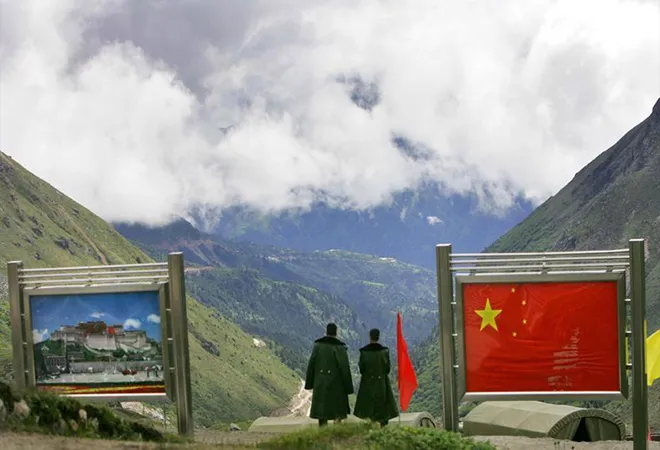
China’s current aggression on the Doklam plateau coupled with its reliance on an 1890 treaty between itself and Britain to claim sovereignty over the 89 square mile territory perfectly demonstrates its strategy of using international law as a tool to achieve military objectives, otherwise known as 'lawfare'.
China's understanding and practice of lawfare
The term lawfare was originally used in academia by Charles Dunlop to describe a 'strategy of using — or misusing — law as a substitute for traditional military means to achieve an operational objective.' Lawfare can take on several different forms. The most obvious is relying on legal norms to justify political or military actions as seen on the Doklam Plateau. Another form is by changing facts on the ground to suit legal positions or pre-empt legal claims. And finally, by misusing domestic legislation to the detriment of another countries strategic objectives.
The Chinese view on lawfare dates back to 1999, with the conceptualisation of 'unrestricted warfare' as a method to extend warfare across all sections of society, not limited by physical battlegrounds. This concept was codified in 2003 with the assignment of 'wartime political work' to the General Political Department, requiring it to conduct "public opinion warfare, psychological warfare, and legal warfare." In 2015, China institutionalised the practice of lawfare in international relations, having created an international law committee under its foreign affairs ministry in order to advance its interests through treaties and legal provisions.
According to Chinese scholars, legal warfare (falu zhan) is 'the use of domestic law, the laws of armed conflict, and international law in arguing that one's own side is obeying the law, the other side is violating the law, and making arguments for one’s own side in cases where there are also violations of the law.' Interestingly, the Chinese view is premised on its belief that the United States was the earliest proponent of lawfare. Obtaining UN authorisation in the first Gulf War and justifying its actions is Kosovo under the aegis of NATO, were seen by China as important tools used by America to provide legal cover for military action.
In practice, China’s aggressive land reclamation in the South China Sea (SCS) was widely seen as an attempt to pre-empt any legal claims by other countries.
Apart from land reclamation, China also passed a series of legislations aimed at legitimising it's so called 9-dash line which encompasses vast swathes of the SCS. The United States Office of the Secretary of Defense in its 2010 annual report on Chinese military activities explicitly highlighted that China "appears to be making concerted efforts, through enacting domestic legislation inconsistent with international law, misreading the negotiations and text of UNCLOS, and overlooking decades of state practice" in order to solidify its claims.
For example, in 2014 China sought to restrict the export of rare earth minerals which are commonly used in technology intensive products and weapon systems under environmental exceptions that the WTO provides. While these restrictions were successfully challenged by the United States and other countries, they serve highlight China's strategic outlook in global power relations.
Lawfare can also take on the form of trade restrictions in order to deny competitors strategic natural resources.
It is important to realise that imperfect lawfare can also have negative consequences. The Philippines request for arbitration regarding disputes between itself and China in the SCS was perceived to be done under American coercion. Despite losing the dispute, China's continuous land reclamation and Barack Obama’s failed 'pivot to Asia' not only hurt American credibility amongst its Asian allies, but also pushed several of the claimants closer to China. While the United States may claim that its Freedom of Navigation Operations ensure that UNCLOS provisions are observed, some SCS littorals have conceded to settling their disputes bilaterally, invariably allowing China to dictate terms favorable to itself.
India’s blunders
India's own susceptibility to legal claims which serve to achieve strategic objectives has an unfortunate history. More often than not, it has been a victim of legal coercion by both China and Pakistan.
India's Tibet policy is a good example. Despite China's invasion of Tibet, India abstained from a UNGA Resolution which explicitly called for the cessation of activities that denied Tibetans their right to self-determination. Even though this error was corrected in 1965, the final blow to the ‘Tibet card’ was dealt by the Vajpayee government in a 2003 joint communiqué with China which recognised the Tibet Autonomous Region as a part of Chinese territory. Soon after this concession China claimed Arunachal Pradesh, which it refers to as 'South Tibet' as part of its own territory.
Another unfortunate example is the Indus Water Treaty, which is one the most unfair to an upper riparian state. Despite receiving the lion’s share of water from the Indus river basin, Pakistan continues to initiate arbitral proceedings and other diplomatic maneuvers to stall India's development projects in the region by relying on the terms of the treaty. The China-Pakistan Economic Corridor is another example of how changing facts on the ground affects legal outcomes. The corridor, which runs through Pakistan Occupied Kashmir, could potentially stall any meaningful bilateral dispute resolution between India and Pakistan, especially after a UN Security Council Resolution endorsed the Belt and Road Initiative.
Due to strategic naivety and failure to establish credible legal arguments in several of its disputes, India may now find itself unable to legitimise its diplomatic positions.
The implications of China's actions on the Doklam Plateau
China's renewed focus on the Indian border should be seen in the wider context of its status as a revisionist power and its provocative actions across all its borders. Its reliance on the 1890 treaty serves as a reminder to Indian foreign policy experts that China prefers to use force as a last resort, relying first on diplomatic actions, information campaigns and legal claims, which also serve to bolster the legitimacy of any military action it may subsequently employ.
India should be wary about the application of this tactic in other disputed areas. Recently for example, China renamed six locations in Arunachal Pradesh under its standardisation procedure, ostensibly as reprisal for the Dalai Lama's visit to Tawang, in order to delegitimise India's sovereignty over the state. Experts highlight that this is a tactic that China has used before when it wanted to press its claims on the Barahoti Pass and in Demchok. The geopolitically important Andaman and Nicobar Islands could also prove to be contentious, with at least one Chinese ambassador explicitly warning that "someone in future may dispute the ownership of the Andaman and Nicobar Islands."
Equally significant is China’s conviction that 'Salami slicing' in the Himalayas is a strategy it can successfully use to its advantage. Its actions in the South China Sea have bolstered its belief that incremental micro-aggression along disputed borders and persistent lawfare can deter hostile military action from fear of Chinese military reprisal.
Taken together, these tactics will continue to force India on the back foot in terms of its wider strategic relationship with China. India has a few options it can review to counter these tactics. The first is to use an unsettled boundary to its own advantage as China has repeatedly done. Brahma Chellaney has argued, for example, that India should begin coloring Tibet differently in its official maps as an act of cartographic diplomacy, indicating that India does not recognise China's claim over Tibet. India could further reiterate its 1954 position that India recognises Chinese suzerainty over Tibet conditional upon Tibet enjoying its autonomy.
Trade is perhaps another useful tool India has to use against China. Many foreign policy scholars have argued that the significant disparity in India-China trade allows India to use it as a political weapon against Chinese aggression. Article XXI of the GATT allows for trade restrictions for the purpose of 'national security'. The application of this measure requires no notification or justification and past experience has revealed that the WTO is generally hesitant to interfere in such matters. Even applied temporarily, it could significantly hurt Chinese imports.
The concept of unrestricted warfare was devised at a time when the military asymmetry between China and the United States was significant. Considering India's own economic and military limitations vis-à-vis China, developing a diplomatic and legal toolkit alongside military power to check Chinese adventurism and to advance its own interests in contentious areas is an option that is worth considering.
The views expressed above belong to the author(s). ORF research and analyses now available on Telegram! Click here to access our curated content — blogs, longforms and interviews.




 PREV
PREV


